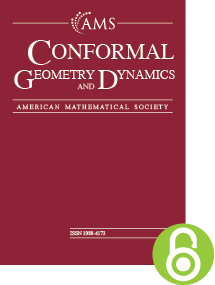The shape of the Ford domains for $\Gamma _0(N)$
HTML articles powered by AMS MathViewer
- by Antonio Lascurain Orive
- Conform. Geom. Dyn. 3 (1999), 1-23
- DOI: https://doi.org/10.1090/S1088-4173-99-00030-2
- Published electronically: February 9, 1999
- PDF | Request permission
Abstract:
This is a second paper on the Ford domains for the Hecke congruence subgroups \begin{equation*} \Gamma _0(N) = \left \{ \begin {pmatrix} a & b \\ c & d \end{pmatrix} \in \mathrm {SL}(2, \mathbb {Z}) \mid c\equiv 0 \mod N \right \}. \end{equation*} The author establishes techniques to calculate the number of sides of these domains; in the process the shape of such polygons becomes apparent in many cases. Explicit formulas are given for numbers which have no more than four prime factors. The main result (Theorem 1) exhibits the existence of a universal symmetric polynomial which evaluated at $p_1,p_2,\dots ,p_r$ yields the number of finite vertices of the Ford polygon for $\Gamma _0(N)$, for all numbers $N=p_1\,p_2\dotsb p_r$ whose prime factors are larger than a constant which depends only on $r$. In all cases the formulas are in terms of symmetric polynomials which generalize the Euler $\phi$ function. The techniques developed to count the number of visible isometric circles show that the study of these circles might also be a useful tool to simplify or solve problems in number theory.References
- Alan F. Beardon, The geometry of discrete groups, Graduate Texts in Mathematics, vol. 91, Springer-Verlag, New York, 1983. MR 698777, DOI 10.1007/978-1-4612-1146-4
- James A. Jenkins, On a result of M. Heins, Proc. Edinburgh Math. Soc. (2) 19 (1974/75), no. 4, 371–373. MR 387575, DOI 10.1017/S0013091500010476
- Yasuhiro Chuman, Generators and relations of $\Gamma _{0}(N)$, J. Math. Kyoto Univ. 13 (1973), 381–390. MR 348001, DOI 10.1215/kjm/1250523378
- R. Fricke, Die Elliptischen Funktionen und ihre Anwendungen, part II. ch. 3, p. 349, Teubner, 1922.
- Ravi S. Kulkarni, An arithmetic-geometric method in the study of the subgroups of the modular group, Amer. J. Math. 113 (1991), no. 6, 1053–1133. MR 1137534, DOI 10.2307/2374900
- A. Lascurain, Fundamental Domains for the Hecke Congruence Subgroups, Columbia University, Ph.D. thesis, 1989.
- A. Lascurain, Ford Polygons for $\Gamma _{0}(N)$, Boletín de la Sociedad Matemática Mexicana, Vol. 39, p. 1-18, 1994.
- Goro Shimura, Introduction to the arithmetic theory of automorphic functions, Kanô Memorial Lectures, No. 1, Iwanami Shoten Publishers, Tokyo; Princeton University Press, Princeton, N.J., 1971. MR 0314766
- Bruno Schoeneberg, Elliptic modular functions: an introduction, Die Grundlehren der mathematischen Wissenschaften, Band 203, Springer-Verlag, New York-Heidelberg, 1974. Translated from the German by J. R. Smart and E. A. Schwandt. MR 0412107, DOI 10.1007/978-3-642-65663-7
- D. Zagier, Modular parametrizations of elliptic curves, Canad. Math. Bull. 28 (1985), no. 3, 372–384. MR 790959, DOI 10.4153/CMB-1985-044-8
Bibliographic Information
- Antonio Lascurain Orive
- Affiliation: Havre 101, Colonia Villa Verdun, Mexico D. F. 01810 Mexico
- Email: lasc@hardy.fciencias.unam.mx
- Received by editor(s): February 1, 1998
- Received by editor(s) in revised form: November 23, 1998
- Published electronically: February 9, 1999
- © Copyright 1999 American Mathematical Society
- Journal: Conform. Geom. Dyn. 3 (1999), 1-23
- MSC (1991): Primary 11F06, 20H10, 22E40, 30F35, 51M10
- DOI: https://doi.org/10.1090/S1088-4173-99-00030-2
- MathSciNet review: 1668275


